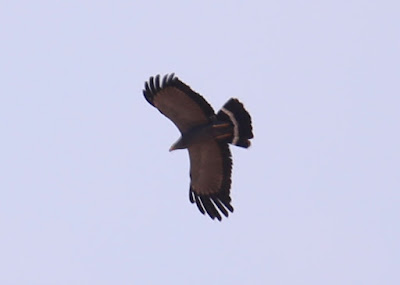African Harrier-Hawk -
Polyboroides typus
The South Luangwa National Park is the largest safari destination in Zambia. Situated half way up the course of the relatively unspoilt Luangwa river valley. The park has been in operation since the 50's. Our camp, Chinzombo was a permanent camp set on an oxbow lake right on the river towards the Southern end of the park. On one of our 5 days we elected for a big adventure driving North for an all day trip with a packed lunch. We ventured into the Lion plain - an area where the camps were already closed as the rains were setting in. The result ? We had the whole park, an area perhaps the size of an English County, all to ourselves ! At some points we worked out that we were probably 30 miles from the nearest other human beings. Deep into the bush.
Some of the most beautiful features of the park are its ebony glades. The trees line up alongside historic water courses. We were lucky enough to take in quite a few of these during our big adventure. Simon Barnes, the excellent sports and travel writer has written a book called the Sacred Coombe which focuses particularly on South Luangwa with which he clearly fell in love. The premise of his book these secret spiritual places and journeys. Not in any hippy sense but just a personal and quiet spiritual sense - renewal through these secret hidden beautiful spaces in nature. These are the places and moments we need to seek out to remain whole in this world.

I forget the name of each "glade" - the combination of beautiful shade and trees though was stunning - entirely different from the usual "Miombi" or Acacia shrub that we are used to traveling through in Africa. You wouldn't have felt out of place sat next to some form of African elf. I haven't paid enough attention to trees in my life - utterly deserving or portraits. Family portraits here.
Before I get onto the encounter with the African Harrier-Hawk I had a lovely photo session with a buffalo attended by a Yellow-billed Oxpecker.
This is first time I have actually looked at a buffalo properly through a lens.
And this was the shot I wanted. Riding as if in the turret of a tank - or perhaps some undersized jockey in a bizarre race. In any event entirely in command of its vehicle or mount - or so it thinks ! I love this picture - it goes into a safari top ten of shot so far in my life.
That is a big lump of beef. It was a long day with some fantastic encounters. The Harrier-Hawk was spotted soon after resting on the sandy bank of a lake edge. A long way off so you will excuse the quality of the pictures.
The face on the his bird is flushed red - I am not sure if this is associated with males in breeding or why this happens. The overall plumage a very smart grey with a barred front.
The bird then flew and I did my best to crank out some shots in flight that allow a solid identification. These birds are quite long legged and adapted for winkling out nestlings and lizards from cavities and chicks from weaver nests. They are often seen dangling upside down in order to access difficult sell spaces.
These birds are fairly widespread with a population of a million spread across the bulk of Sub-Saharan Africa. Still a first for me and better picture is needed.
African Harrier-Hawk,
Polyboroides types
South Luangwa National Park, Zambia
November 2018




















